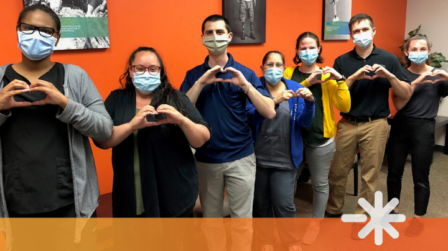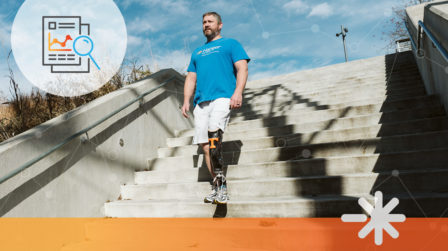Up-to-date information about Hanger Clinic’s response
Limb Loss at the Hip
Amputations at or just below the hip–described as hemipelvectomy, hip disarticulation, and transpelvic amputations–are most commonly caused by trauma, cancer, or severe infection. Although there are many challenges to consider and manage with this type of limb loss, with the right support, clinical expertise, and prosthetic technology, it is possible to lead an independent life.
What to Expect on Your Journey
Because of the complexities that come with the loss of your hip, knee, and ankle joint, it is imperative that you work with healthcare professionals who have experience treating this condition and are dedicated to forming a collaborative care environment with your long-term goals in mind. Your entire care team can help you navigate the road ahead and can put you in touch with peer support groups who have faced similar journeys and want to share their experiences with you.
Sitting and Standing
The use of a prosthesis following amputation at the hip impacts how you bend at the hip to sit and stand. Learning to sit and stand after your amputation is an important early milestone.
Walking
Walking with a prosthesis at these levels of amputation can be quite challenging at first. Being fit with an appropriate prosthesis and working with an experienced physical therapist can be important resources in resuming walking with a prosthesis.
Rehabilitation & Prosthetic Fit Considerations
Rehabilitation for hip disarticulation generally follows the amputation rehabilitation timeline, but there are some special considerations.
The first and most important part of your prosthesis is designing a socket that is comfortable, does not interfere with bodily functions, and properly supports your body weight. Your prosthesis will be custom designed to fit you and your needs. Important considerations include the length of the thigh segment, the type and placement of the prosthetic knee, the length of the shin, and the type and placement of the prosthetic foot and ankle. A period of learning is expected, and modifications may be required as you learn to use your devices and discover what is most comfortable for you.
Prosthetic Hip Joints
Unlike your anatomic hip joint, the prosthetic hip joint of your prosthesis will be placed near the front of your body. This allows you to keep your weight behind the joint, reducing the likelihood of a fall.
Prosthetic Knee Joints
Knee stability is a fundamental concern at this amputation level. The prosthetic knee mechanisms used with these prostheses are often selected based on their mechanisms of ensuring stability.
Prosthetic Feet
Prosthetic feet can also contribute to the stability of the prosthesis. Foot selection is often influenced by the need to maintain a safe, stable prosthesis.
More About Prosthetic Knees >
More About Prosthetic Feet >
Rest
More so than at most other amputation levels, time not wearing your prosthesis is an important part of maintaining your health after amputations at the hip. A sitting socket, designed to keep your pelvis and spine in proper alignment when not wearing your prosthesis, can help prevent development of musculoskeletal issues like scoliosis. Additionally, crutches and assistive devices can help you get around at home and community while reducing your risk of fall when you are not wearing your prosthesis.
You are Not Alone
Amputation at the hip can be challenging to fit with a prosthesis because the compound loss of the foot, ankle, knee and hip make it more difficult to achieve comfort and stability, and making use of a prosthesis requires a lot of energy. Some hip disarticulation (HD) amputees and transpelvic (TP) amputees are often discouraged from considering the use of a prosthesis by well-meaning healthcare professionals and family members. Others may have attempted to use a prosthesis and, in frustration, decided they could be more mobile using crutches or a wheelchair. If you or a loved one find yourself in any of these difficult situations, know that our lower extremity prosthetic experts are experienced at successfully fitting high-level amputations. We have many HD and TP patients who walk with a prosthesis everyday and participate in most life activities. We are willing to work with you to help you reach your goals.
At Hanger Clinic, we will be with you every step of the way. Through our clinical expertise and partnerships with rehabilitation institutions and peer support groups across the country, we will do everything we can to help you achieve your highest personal goals.
Request a Free Evaluation
If you or a loved one are facing amputation at or below the hip, we may be able to help. Schedule a free consultation today.



